Executive Roundtable on Satellite Mobility Solutions for Broadcast Applications
by Bernardo Schneiderman
Los Angeles, Calif. April 15, 2022--The broadcast sector has been one of the key markets for satellite mobility solutions for various broadcast applications. Each year the entry of high powered satellites and new antenna technologies are providing more flexibility and a portfolio of innovative options for broadcasters and content distributors. We invited some manufacturers of satellite antennas for the broadcast market in a virtual roundtable on this important topic.
We can consider for the Broadcast SNG applications both vehicular antennas and the Flyaway and back pack antennas. The majority of the manufacturers for vehicular solutions still using parabolic antennas but we have now few manufacturers that are providing flat panel antennas for this market. This segment provides antennas in C-band, Ku and Ka-Band with various diameters (from 60 cm–2.4 meters) that now could be used worldwide.
The other segment are Flyaway antennas which can be hand-carried in small cases or in backpack to a site and assembled on the spot to uplink the news or content from remote locations. The antenna could be manually or automatic pointing to the satellite to stablish the link. The antenna cases could be transported in planes or land/maritime vehicles. The antenna on the site is mounted on a tripod with the option of manual or automatic positioning to close the link with the Satellite.
A recent NSR Study on Land Mobile via Satellite includes Satellite News Gathering (SNG) and Flyaway antenna equipment are essential for the broadcast and video markets. According to the report the Land-Mobile Communication market will grow from US$ 1.8 billion in 2020 to US$ 16.0 billion in 2030. Despite the moderate impact of COVID-19 during the last two years, in the Communication on the Pause (COTP) segment, NSR forecasts growth from US$ 1 billion to US$ 6 billion in the next ten years.
The company executives participating in our virtual roundtable include: Krystal Dredge, Marketing Director-AvL Technologies; Bill Awada, Chief Technology Officer-C-COM Satellite Systems; Tim Shroyer, Chief Technology Officer--Communications & Power Industries' (CPI's) Satcom and Antenna Technologies Division; and Darin Anderson, Director of International Business Development--ThinKom Solutions. Excerpts of the virtual roundtable follows:
Satellite Executive Briefing (SEB): Please describe your portfolio of flat panel antennas or Satellite News Gathering (SNG) equipment for the broadcast market?
AvL: AvL Technologies provides the most comprehensive range of SNG antenna apertures and the widest range of frequency bands in the
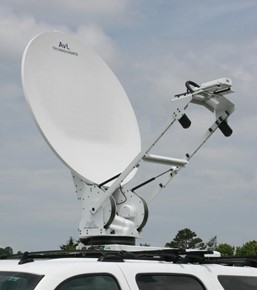 |
| AVL SNG Ka-Band mobile antenna |
industry, ranging from 85cm to 2.4m, and covering all broadcast satellite frequency bands including C, Ku, DBS and Ka. AvL’s SNG antennas are mostly vehicle-mount, but some SNG users prefer the case-packed versions that assemble and are on-air within minutes.
C-COM: C-COM manufactures over 20 different COTP antenna models covering Ka, Ku and C bands. Our products have been deployed worldwide with most satellite service providers. While any of these antennas can be used for SNG markets, the 75cm and 1.2m vehicle mounts along with the 1m Manpack have been most popular. The Electronically-Steered Phased-Array Flat Panel Antenna, which is under development, will operate in Ka-band over GEO, MEO, and LEO satellite constellations targeting land mobility applications including SNG markets. The same antenna technology can be extended for use into other markets such as maritime and airborne.
CPI: CPI has a broad family of flyway and mobile antennas, amplifiers/BUCs, and other RF products optimized for SNG applications. This full range of products, whether individual components or fully integrated mobile compatible satellite terminals allows CPI’s varied customer base to be able to choose the products and/or systems that best suit their SNG and other mobile broadcast application needs. iNetVu® FLY-74G Flyaway Antenna
Looking at integrated systems, CPI’s Next Generation flyaway terminals include apertures from 60 cm to 2.4m in size, each using lightweight carbon fiber reflectors, packed in minimum volume IATA-compliant cases, for fast installation and fast satellite acquisition. They include antenna feed and RF equipment quickly configured for Ka-band, Ku-band or X-band to support both SNG and military users.
CPI’s flyaway terminals feature simple manual or automated satellite acquisition. Our industry-unique optional auto-pointing kit, supplied with most of our flyaway terminals, simply clips onto the antenna and provides an upgrade to fully automatic pointing capabilities. The powerful onboard controller allows for highly intuitive, single-button control or a graphical user interface experience via a Web UI to deskill the operation of locating and acquiring the desired satellite.
Manual pointing minimizes the terminal weight and cost but the optional auto-pointing kit can be included at any time to bring the benefits of
For those new markets looking to take advantage of the rapidly growing Ka-band market, CPI has recently introduced the GaNLink™ 80W solid state BUC (model SB49KOA). This state-of-the-art Gallium Nitride powered BUC provides all the flexibility and rugged design that CPI is known for in the Ka-band amplifier market, but with a small, lightweight and highly efficient package. Including single or multi-band options, this BUC is designed to be portable, while handling the transmission in the most challenging of environments.
fully automatic satellite acquisition.
CPI’s line of mobile antennas includes apertures from 1.2m to 2.4m in size and support operation in Ka-band, Ku-band, X-band or C-band
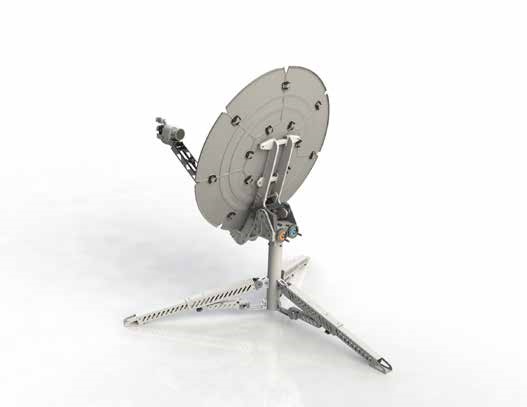 |
| CPI C125FA Flyaway Terminal |
with interchangeable feeds and RF equipment. Their high-precision aluminum/carbon fiber reflectors with state-of-the-art design provide exceptionally low sidelobe and cross-polarization performance, well within INTELSAT and EUTELSAT requirements. Cable drive mounts ensure minimum stow height on the vehicle while providing precision pointing and alignment. Boom-mounted and saddlebag HPA options are available to cover every EIRP requirement.
CPI continues to offer a number of compact outdoor TWTAs that have served the SNG and mobile broadcast markets for the last 10 to15 years. These industry workhorses continue to support DSNG vehicles and other flyaway applications all over the world, whether for news, disaster recovery or a myriad of other applications.
The benefit of these traveling wave tube-based products is their inherent wideband capabilities. Offering the standard Ku-band (14.0-14.5 GHz) along with variations in extended Ku-band (12.75-14.5 GHz, 13.75-14.5), there are now options for specialized ranges, including up to 14.8 GHz.
ThinKom: ThinKom offers a range of phased-array flat-panel vehicular mounted satellite antennas for communications on the move (COTM) in SNG applications. Based on ThinKom’s patented VICTS (Variable Inclination Continuous Transverse Stub) technology, the low-profile lightweight antennas provide high-quality voice, data and broadcast-quality video in real-time from moving vehicles operating at highway speeds on and off the road without stopping the vehicle to deploy a fixed satellite dish or waiting for a blockage recovery.
The ThinSat® 300 COTM antenna has been on the market for more than 10 years with hundreds of units deployed around the world, providing continuous connectivity in regions where terrestrial cellular networks are limited or nonexistent. The antenna has a bandwidth-efficient 30-inch Tx antenna with a cross-pol isolation of 30dBi, which provides a ‘fat data pipe’ return link to the satellite (perhaps 1080i or 4K) with the right compression ratios, the user doesn’t need to over-purchase larger amounts of MHz from the satellite operator to transmit from a desired location in high resolution.
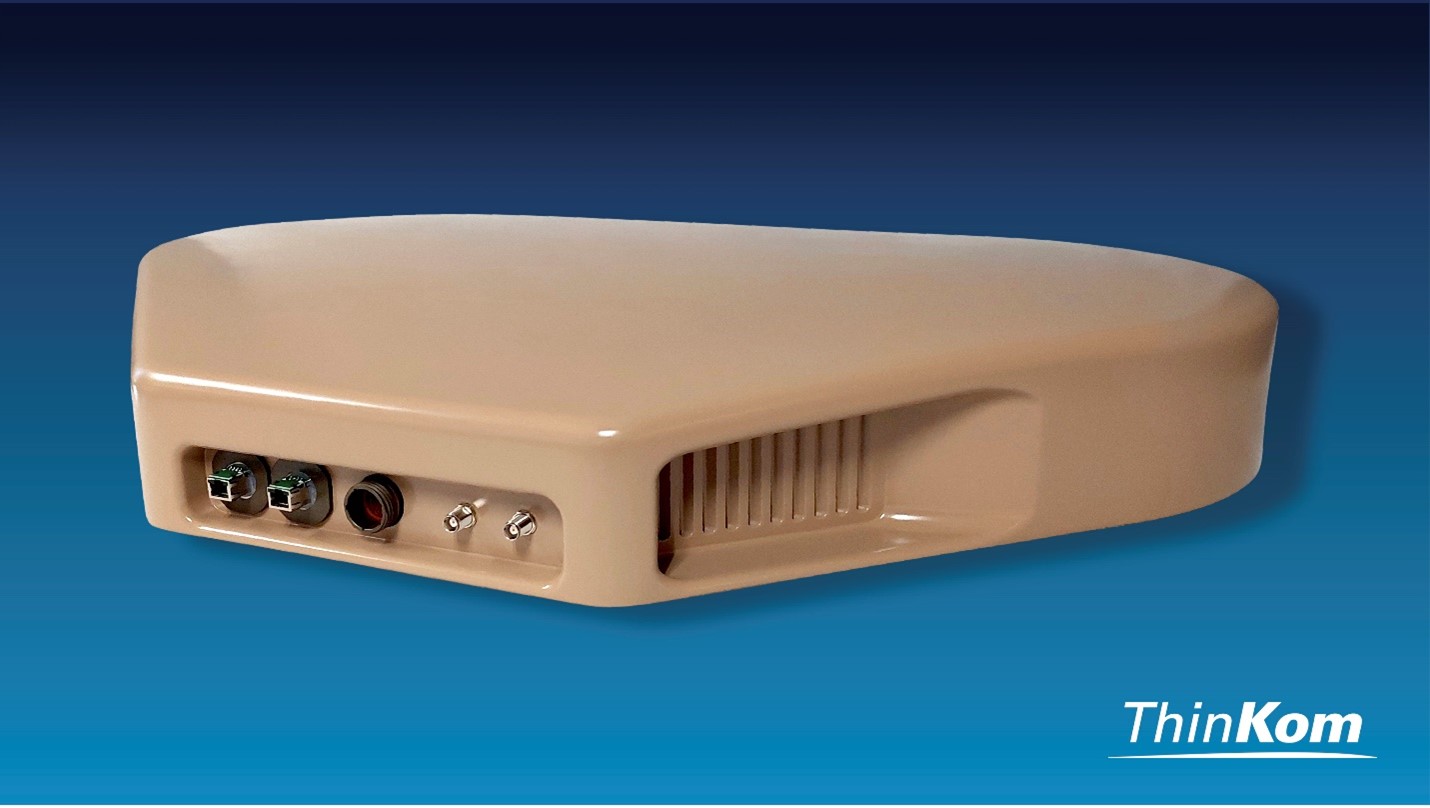 A good example of the VICTS phased array in a COTM SNG environment was the 2019 Solar Challenge which covered a 3,000-km race course across the Australian Outback. Two of the teams were able to sustain uninterrupted voice and broadband video throughout the race using the ThinKom antennas mounted on chase vehicles, providing live feeds to news media worldwide from the high-speed vehicles despite extreme conditions of heat and dust storms. The Dutch team, for instance, streamed more than 77 hours of live HD video on its YouTube and Facebook challenges.
A good example of the VICTS phased array in a COTM SNG environment was the 2019 Solar Challenge which covered a 3,000-km race course across the Australian Outback. Two of the teams were able to sustain uninterrupted voice and broadband video throughout the race using the ThinKom antennas mounted on chase vehicles, providing live feeds to news media worldwide from the high-speed vehicles despite extreme conditions of heat and dust storms. The Dutch team, for instance, streamed more than 77 hours of live HD video on its YouTube and Facebook challenges.
This year we are introducing a new COTM antenna that will provide SNG customers access to the new satcom networks operating in the Ka-band frequency range using satellites in geostationary (GEO), low and medium earth orbits (LEO and MEO) and highly elliptical orbits (HEO).
Do you have any plans to launch any new products or services at the NAB 2022, or if not, what will you be showcasing at the NAB or in the coming months for the Broadcast market?
AvL: AvL is not launching any new products at NAB 2022, but did just introduce a new Comms on the Move (COTM) terminal for vehicle operations, and new XY antennas that operate in GEO and MEO with a roadmap for LEO. The COTM terminal was developed for military applications, operates in GEO and MEO, and is reconfigurable for Ku- and Ka-band, which has commercial SNG applications. The XY antennas also were developed for military applications, but operate with commercial networks
C-COM: We will be showcasing several products at the NAB Show this year including our new Ka 74cm antenna which has just received
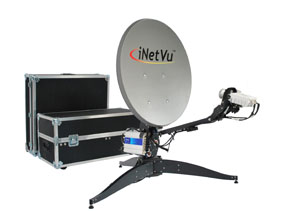 |
| C-COM's iNetVu® FLY-74G Flyaway Antenna |
type approval from Eutelsat over their Ka-band Konnect service. We will also display our 1m Manpack Ku band, Flyaway 74cm, and the 98cm vehicle mount antennas. Attached are pictures of these models.
CPI: CPI has been expanding our SNG products and will be exhibiting some of our innovations at NAB 2022. With our C125FA terminals, we have increased the ruggedness and environmental protection of our drive system. Our optional auto-pointing kit, unique in the industry, able to quickly clip onto the manual drive system, is even easier to use.
CPI also offers a full line of LNAs, LNBs and other RF components that support specialized integrators that build and offer bespoke SNG and vehicle mounted systems for satellte communications.
ThinKom: Yes. ThinKom’s new ThinSat® Ka500 VICTS phased array offers an unprecedented combination of network flexibility, multi-constellation interoperability and compact low-profile form factor for continuous uninterrupted COTM applications. The low-profile unit measures just 35 x 35 inches and 5 inches high. It weighs only 75 pounds and easily mounts on standard roof racks.
Considering the rapid deployment of satellite constellations in the Non-GEO orbits such as LEO and MEO, how are you addressing in the new environment with Ku and Ka-Band for the broadcast, media and streaming market?
AvL: AvL’s SNG antennas operate with high-throughput GEO networks in both Ku- and Ka-bands with the configuration, including band change capability, provided for the SNG operator. Some AvL Ku- and Ka-band SNG GEO antennas and terminals are upgradable to MEO, but we have not seen demand for this capability with SNG customers
C-COM: Our current development of flat panel Phased-Array antenna in Ka band has been designed to work with non-GEO constellations. At the moment we have no plans to develop a Ku band option as we believe that the market potential lies in higher bands.
CPI: CPI’s broad portfolio of antenna products includes flyaway and mobile antenna terminals for applications where users need lightweight yet rugged, compact and easy-to-use antennas that are deployable in a variety of environments. These antennas terminals offer a cost-effective solution for some MEO constellations. Coupled with CPI’s Ku- and Ka-band amplifiers/BUCs and RF components, we are able to provide these products as standalone or full systems.
CPI is the only satcom amplifier manufacturer in the word offering products using solid state, traveling wave tube and klystron technologies, giving our customers the widest selection to provide the solutions that they and their customers determine are best for their applications. Specifically in Ka-band, we continue to expand CPI’s offering of power amplifiers/BUCs in all power levels.
ThinKom: ThinKom’s Ku- and Ka-band phased arrays are designed to communicate via GEO, MEO, LEO and HEO satellites. When working on fast moving LEO satellites, the antenna switches rapidly and seamlessly without any service interruption as the satellites rise and set. Partnerships are in place with Telesat’s new Lightspeed Ka-band network, and we plan to offer COTM customers a choice for operating either on Ku and Ka frequencies as these new lower-orbiting satellite constellations come into service.
What are the key trends that you see in mobility applications for the broadcast market?
AvL: AvL is seeing a great deal of demand for SATCOM mobility with military customers, but not with broadcast markets. Broadcast users often use 5G cellular services for mobile streaming – it works well and is low cost. SATCOM COTM products, like AvL’s COTM terminal, are advancing rapidly and enable significant improvements, including GEO/MEO operations, band and network changes in the field, low power consumption and high throughput. But SATCOM COTM will not be cost competitive with 5G cellular for some time, so the appeal for SNG and commercial streaming is likely several years out.
C-COM: We expect the ongoing development of mega satellite constellations by different companies to fuel the demand for flat panel antenna solutions especially for mobility applications. The transport industry such as vehicles, trucks, trains, buses, ships and airplanes will enjoy a more affordable, more reliable, and higher-speeds “InTransport” broadband connectivity.
CPI: This is a dynamic area, as the idea of what can be done on a mobile platform continues to expand. Services that were once required to have dedicated fixed infrastructure now can be packed up in transit cases and deployed very quickly to almost anywhere in the world.
With the rollout of 5G mobile network services, we anticipate that some applications may migrate away from satcom. However, the demand for bandwidth to developing markets all around the world, combined with new services being offered to technology-savvy customers and regions, continues to drive demand for satellite-based services. We look forward to seeing the roles that terrestrial versus satcom systems play in it as it develops, as each have their areas of specialty.
ThinKom: There is growing demand for seamless low-latency data transfers between satcom and/or terrestrial networks. Achieving 5G at 1 to 70 msec latency will require terrestrial-based links. Latency rates for satcoms will be on the order of 100 msec for LEO and up to 1 sec for MEO and HEO satellites. GEOs will have latencies of 1 sec or greater.
For satellite COTM, latency is only one of the factors to be considered. True mobility in satcom must also address line-of-sight (LOS) blockages and outages. When the LOS is interrupted by going behind a tall building or tree, or going under an overpass or tunnel, the connection to the network must be re-established seamlessly. While the antenna hardware needs to be capable and reliable of minimizing interruptions, the networks and modem capabilities at the remote (vehicle) and hub/teleport side are equally important. The faster the handshake, the faster restored links allow for the data/transmissions to flow effortlessly in both directions, thus maintaining a good quality of service for the application. Blockage and recovery are agnostic to GSO or NGSO satellites, and in some case NGSO recovery will need increased antenna and network smarts.
An additional consideration is the proliferation of terrestrial 5G networks for telco. International regulatory requirements forbid satellite terminals to interfere with these networks. ThinKom’s VICTS phased-array technology complies with this WR-19 ESIM requirement, as well as other important regulatory requirements for NGSO operation, such as the ITU Article 22.
-------------------------------------------
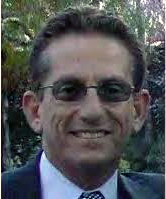
Bernardo Schneiderman is a correspondet of Satellite Markets and Research and the Principal of Telematics Business Consultants. He can be reached at: info@tbc-telematics.com





